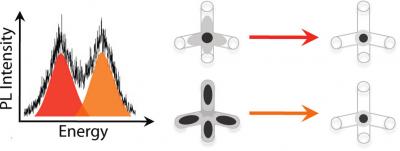Lawrence Berkeley National Laboratory (Berkeley Lab) of the U.S Department of Energy (DOE) has developed artificial semiconductor nanocrystal molecules and observed them working against the basic principle of photoluminescence called Kasha's rule, which states that when light is directed on a molecule, it will emit light that is fluorescent or phosphorescent only from its lowest energy excited state.
 semiconductor tetrapods developed by Berkeley lab
semiconductor tetrapods developed by Berkeley lab
Paul Alivisatos, Berkeley lab director stated that a molecule of semiconductor nanocrystal, in a tetrapod form emitted light from its multiple energy excited states. Since these nanocrystal molecules are more photostable than organic molecules, they are used in applications of optical sensing and light emission processes that include LEDs and imaging labels. According to Charina Choi, lead author of Nano Letters, semiconductor nanocrystal tetrapods have excellent structures similar to that of methane.
Alivisatos, Choi, and their team developed a core or shell tetrapod of cadmium-selenide (CdSe) and cadmium-sulfide (CdS); which had a quasi-type-I band arrangement to enable 30 to 60% yield of high luminescence quantum. The tetrapod’s highest occupied molecular orbital (HOMO) includes an electron hole inside the cadmium-sulfide core. But the lowest unoccupied molecular orbital (LUMO) may be centered inside the core as well as be located in the four arms, while the lowest unoccupied molecular orbital (LUMO+1) will be present within the four arms of CdS.
It was observed through single particle photoluminescence spectroscopy that when a core or shell tetrapod of CdSe or CdS is excited, besides the expected result of photon emission at the HOMO-LUMO energy gap, there was another photon emission at a higher energy gap that shifts from LUMO+1 to HOMO.
CdSe and CdS core or shell tetrapods can measure forces in nanoscale sensors. Past research of Alivisatos and Choi revealed that tetrapods emission wavelengths will shift as a result of local stress exerted on their four arms. When the tetrapod arms are bent by stress, it disturbs the electronic coupling of the tetrapod's heterostructure that result in color changes of the light emitted. It also modifies the emission intensity ratio from the two excited states, explained Choi. By modifying the arm length of CdSe and CdS core or shell tetrapod, there are chances to control electronic coupling and band alignment within the heterostructure, resulting in emissions from multiple excited states, suitable for nano-optic applications.